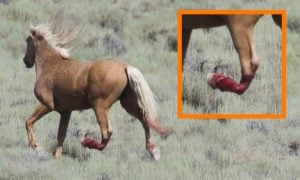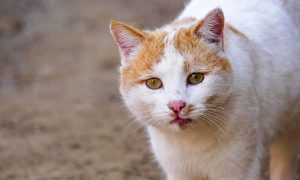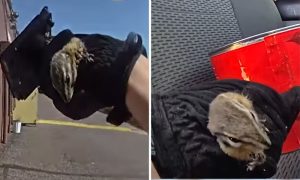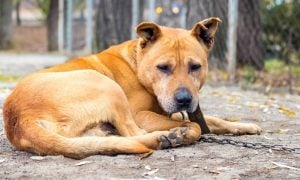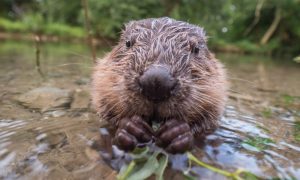In today’s world of mass-produced, cheaply-made products, it’s more important than ever that people who care about animals and the planet take the time to make informed decisions about what they’re choosing to support.
Many commonly used and accepted products — from moisturizers and sunscreens to fertilizers and cell phones — can hurt animals and the environment, whether through their production or from chemicals leaching into land and water when not disposed of properly.
Researchers also have documented that many of the same ingredients that cause harm for the planet also have been linked to hazards for humans — including increased likelihoods for certain cancers, reproductive issues, Parkinson’s disease, and Alzheimer’s.
The good news is that it’s easier than ever to make more compassionate choices, with numerous (and growing) numbers of companies offering affordable, alternative options for caring consumers.
Here are 10 types of products for you to consider with a critical eye, and some of our favorite ways you can quickly — and easily — shift your choices to help the animals we all love and this precious planet that is our home.
1. Sunscreens
Who They Hurt: Marine animals including urchins, dolphins, fish, turtles, and corals
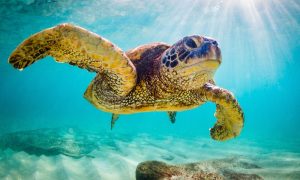
Representative Image (shanemyersphoto/ Adobe Stock)
Many sunscreens contain chemicals that are highly toxic to marine life — including corals, turtles, dolphins, sea urchins, and fish — and can lead to deformities, stunted growth, and damaged reproductive and immune systems. The National Park Service estimates that between 4,000 tons and 6,000 tons of sunscreen enter coral reefs every year. Check sunscreen ingredient lists for the following hazards — Oxybenzone, Benzophenone-1, Benzophenone-8, OD-PABA, 4-Methylbenzylidene camphor, 3-Benzylidene camphor, nano-Titanium dioxide, nano-Zinc oxide, Octinoxate, and Octocrylene — and leave them on the shelf, or commit to purchasing reef-safe sun protection (and make sure they are vegan and cruelty-free brands like these!)
Better yet, opt for options that won’t introduce any foreign substances to waterways by wearing Ultraviolet Protection Factor (UPF) sunwear, including sunglasses and long-sleeved shirts or pants, and seek shade during the hottest parts of the day.
2. Palm Oil
Who It Hurts: Orangutans, pygmy elephants, Sumatran rhinos, other rainforest dwellers
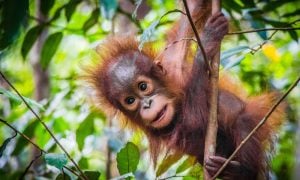
Representative Image (Robert/Adobe Stock)
Palm oil production is razing huge swaths of rainforest land, including in Sumatra and Borneo, leading to deforestation and biodiversity loss and contributing to forest fires that displace or burn animals alive — including orangutans and pygmy elephants. Unfortunately, experts warn that more than half of packaged products in the United States have palm oil, including cookies, pizza dough, chocolates, and personal care products like shampoo or deodorants.
Look for palm oil in its various forms on ingredient lists — including palm kernel, palmitate, palm stearin, sodium kernelate, palmityl alcohol, and sometimes even “vegetable oil.” Because palm oil can be produced using many fewer natural resources than other similar oils, conservation experts advise caring consumers to write to companies and advocate for certified, sustainable palm oil rather than boycott products all together. You can check out companies’ palm oil sustainability scores here.
3. Microplastics
Who They Hurt: Fish, turtles, dolphins, and other marine dwellers
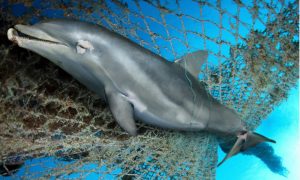
Dead Dolphin in Drift Net (Alamy)
The dangers of disposable plastic straws, shopping bags, and plastic beer or soda rings are well documented, with growing numbers of cities banning or phasing out their use. But microplastics — defined as pieces of plastic that are less than 5 millimeters, or about the size of a pencil point — are just as toxic for marine dwellers, who often eat them and then can suffer from cancer or give birth to offspring with deformities or stunted growth. Microplastics can result when larger plastic products break down or take the form of microbeads, added to some exfoliants or beauty products that get washed down the drain and into waterways: Watch out in ingredients lists for polyethylene, polypropylene, and polymethyl methacrylate. But they also can enter oceans and streams when people wash their clothes, with experts noting each washer cycle can release millions of microfibers.
Ways you can help the planet are by ditching single-use plastic items (including water bottles), packing groceries into reusable fabric bags or backpacks and investing in a sturdy reusable water bottle and travel mug (as disposable paper cups can be coated in harmful chemicals, too!) You can check to see if products have microbeads by checking out the Beat the Microbead’s free search tool.
4. Pesticides and Fertilizers
Who They Hurt: Birds, bees, other pollinators, fish, aquatic insects, and sometimes companion animals
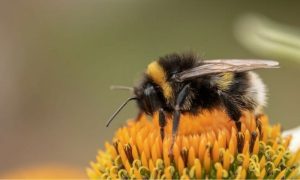
(Myriam Zilles/Pixabay)
In 2020, the Center for Biological Diversity reported that the U.S. Environmental Protection Agency (EPA) had approved through 2035 the use of a slew of pesticides, including Paraquat and pyrethroid insecticides, linked to increased risk for human health concerns — including Parkinson’s, Alzheimer’s, autism, and learning disorders in children — as well as being toxic to pollinators and fish. Sadly, many easily recognized fertilizers and pesticides sold at local garden centers also contain perils. If you care about pollinators, experts warn against using any products with glyphosate, pyrethroids, neonicotinoids (commonly listed as imidacloprid, clothianidin, dinotefuran, acetamiprid, and thiamethoxam), 1,3-D(ichloropropene), 2,4-D(ichlorophenozyacetic acid), and atrazine — which can be found in products like Bayer’s Roundup, Monsanto’s Roundup, Telone, Ortho Weed B Gon, Spectracide, Weedone, and Raid Roach Fogger. The toxic chemicals in these products can find their way to aquatic animals, too, during storms or lawn waterings and the resulting runoff into neighborhood drains.
For a compassionate alternative, use natural deterrents like Neem or garlic oils or make your own using common household items like dish soap, white vinegar, and water in these fantastic do-it-yourself recipes. Peppermint essential oil or diatomaceous earth also can help redirect unwanted insect guests, including ants and aphids. Companion planting — which you can learn more about in this helpful guide — also can help prevent unwanted garden guests.
5. Clothing Made From Animals and Fast Fashion
Who It Hurts: Fur-bearing animals, crabs, lobsters, turtles, penguins, seals, manatees, sea otters
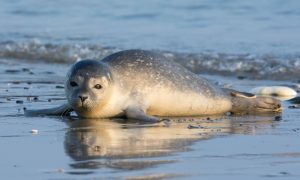
Representative Image ( Iwona/Adobe Stock)
Lady Freethinker has written frequently about the cruelty of using animal furs and skins for human clothing — and we continue to encourage people to choose vegan alternatives to cruelly sourced wools, leathers, and furs, the processing of which uses massive amounts of resources, contributes to the climate crisis, contaminates waterways, devastates land, and pollutes the Earth. Leather processing, for example, uses formaldehyde, cyanide-based finishes, and lead, and tanning leather produces hazardous wastewater and solid waste, creates air pollutants, and exposes workers to harmful chemicals. The impact of making wool is also devastating, as the climate cost of sheep’s wool is five times greater than conventionally grown cotton, according to a report from the Center for Biological Diversity. The chemically-intensive process of cleaning wool after it’s ripped from sheep also kills aquatic life and pollutes waterways.
The rise of synthetic “fast fashion” — or creating cheap, throw-away clothing — has its dangers, too. When cleaned in a washing machine or dryer, clothes made from polyester, nylon, and acrylic release millions of microfibers that can find their way into the stomachs of crabs, lobsters, fish, turtles, penguins, seals, manatees, sea otters, and other marine dwellers. These fibers can block these animals’ digestion and lead to starvation. Meanwhile, many fabrics, including viscose and rayon, are made from bleached wood pulp from forests, including in Indonesia and the Amazon — the deforestation of which leads to tragic biodiversity loss.
Precious natural resources also go into making clothes: from fossil fuels used to create polyester and nylon, to water- and pesticide-intensive cotton production. Since most people need to wear clothing to function in mainstream society, experts advise buying high quality clothes that will last a longer time, buying only what you need and love, repairing ripped clothing rather than throwing it away, shopping at thrift stores, and swapping clothing with friends or family when you get tired of it!
6. Seafood, Meat, and Animal-Derived ‘Products’
Who It Hurts: The animals people eat and wildlife, including elk, wolves, bears, coyotes, dolphins, whales, turtles, corals, and birds

(Photo Credit: Jack Gescheidt)
Billions of animals suffer and die horrifically in factory farms and commercial fishing facilities in the United States and worldwide every year to create people’s “food.” What’s not as well known is that eating meat and seafood also contributes to toxic pollution and the suffering and death of countless other animals. Dolphins, whales, turtles and other marine life get entangled in discarded fishing nets; in Mexico, precious porpoises called vaquitas are facing extinction due to human-caused issues. Other precious creatures, including corals and sea grass, also can be decimated by destructive practices including bottom trawling and driftnets. Forests cleared to make room for grazing cattle endanger wildlife that roams those areas — including birds who lived in the trees, as well as predators or herbivores who no longer are welcome in their historic range. Just look to the Point Reyes National Seashore, where the government has approved the shooting of rare Tule elk who now share their foraging land with privately-owned cattle, or to the massive number of wolves and coyotes being killed due to a relatively small number of depredations on cattle who are grazing on leased lots in their range.
The good news is that there are many delicious, affordable, and accessible plant-based alternatives to these animal-derived products: including plant-based cheeses, burgers, and seafood! We invite you to take your tastebuds for an adventure and give plant-based alternatives a fair shot today — the animals will thank you!
7. Improperly Disposed Medications
Who They Hurt: Fish and other marine dwellers
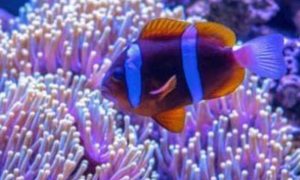
(David Clode/Unsplash)
If you end up with extra medications — for yourself, or even your companion animal — don’t flush them down the drain or throw them into the garbage! Improperly discarded medications can end up in sensitive ecosystems where they can hurt animals. The substances in high blood pressure medications, or beta blockers, can harm the growth and development of marine dwellers like oysters, clams, or muscles, while the chemicals in oral contraceptives can hurt the endocrine systems of fish, for example. Talk with your doctor or your veterinarian about only paying for and carrying out the amount of medication that you’re prescribed. If you do end up with other medications, find a drug “Take Back” location near you that’s committed to disposing of the medications in a safe and environmentally friendly way by checking out this free search tool!
8. Improperly Disposed or Stored Drugs — Including Marijuana
Who They Hurt: Dogs, cats, other companion animals

Representative Image (Joe Parks/Wikimedia Commons)
Dogs or cats who ingest marijuana — from the streets, or raided personal stashes — may become wobbly or hyperactive and have difficulty walking or breathing. They also might drool, or on the severe end of the spectrum, they could have seizures or a coma, according to veterinary professionals.
“Fortunately, these side effects are usually short-lived, but they can still be dangerous and make your pet quite miserable,” one veterinary hospital advised.
To keep your companion animals safe, please make sure that your animals don’t have any access to the things they shouldn’t ingest!
9. Cosmetics and Personal Care Products
Who They Hurt: Rabbits, guinea pigs, mice, rats, fish, dolphins, polar bears, sea otters, and other marine dwellers

Representative Image (Canva)
Although there’s no mandate for it, many cosmetic and personal care products — including lipstick, makeup, shampoo, and deodorant — are tested on animals in laboratories. First, make sure you’re buying products that are cruelty-free using this free search tool! As with all labels, we encourage you to always check ingredients and companies’ claims that their products are “cruelty-free”; the U.S. Food and Drug Administration and Health Canada have not yet legally defined these terms, so there’s no official standard for what makes something “cruelty-free.” A sampling of cosmetics in the UK found that 89 percent of products claiming to be “cruelty-free” or “vegan” actually had animal-derived ingredients, including retinol, keratin, biotin, or squalene (from sharks).
Other products include parabens, which research has linked to human breast cancer and male reproductive issues. To avoid, look for ingredients starting with isobutyl-, butyl-, isopropyl-, propylparaben, methyl-, ethyl-, or isobutyl- to name a few. Butylparaben in particular has been linked to killing coral.
Some brands that we trust include O-Way, Kinder Beauty, and Shared Planet. Whole Foods also has banned parabens as part of their body care standard, while other major retailers including CVS and Target have committed to phasing out products that contain them.
Regardless of where you get your cosmetics, please also make sure that you’re not flushing them down the drain, as all those ingredients will end up in waterways and can hurt animals!
10. Cell Phones
Who They Hurt: Forest dwellers

Representative Image ( jdross75/Adobe Stock)
The rise of smartphones, which typically have about a 2- to 4-year life span before newer models come out, has ushered in a new era of waste and pollution, according to research from McMaster University, which projected that the carbon footprint of smartphones would exceed that of all individual desktops, laptops, and displays. Deloitte Global reported that an estimated 4.5 billion Smartphones worldwide created 146 million tons of carbon dioxide emissions in 2022.
Meanwhile, the chips and motherboards are made from precious metals —like gold, silver, and palladium — mined at a high cost, while every call, video, or text sent via cell phones connects back to a data center that consumes electricity generated from fossil fuels. Cell phones that end up in landfills also can leach toxic metals or liquids into the earth, including lead, nickel, and mercury.
Rather than tossing an old cell phone, recycle or donate it to a charity! You can find a recycling center near you using a free search tool. A lot of fantastic nonprofits also will accept old cell phones, particularly those supporting survivors or domestic violence who may not have a phone of their own.
11. Cleaners
Who They Hurt: Marine dwellers and sometimes companion animals

(Helena Lopes/Pexels)
Disinfecting substances like bleach and hydrogen peroxide can be toxic for animals who come into contact with them. Opt for products that have as many natural ingredients as possible, and beware of “greenwashing” — or companies using labels that things are “eco-friendly,” “green,” “natural,” or “sustainable.” Because there aren’t legal definitions for many of these labels, companies can use them fairly freely without ensuring that their practices actually match consumers’ desires or perceptions.
You can check out the U.S. Environmental Protection Agency’s search tool to see where your favorite cleaning products rank in terms of truly being eco-friendly; or better, yet, you can make your own cleaning products, using safe ingredients like baking soda and white vinegar that you likely already have around the house! Here are just two DIY recipe collections for incorporating more compassionate cleaning routines into your home!
12. Coffee
Who It Hurts: Birds, forest dwellers, companion animals (if ingested)
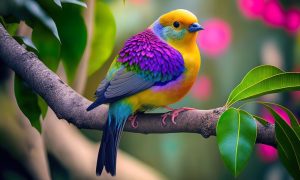
Representative Image (MiaStendal/Adobe Stock)
Unfortunately many of the “cheap” coffees on sale at grocery and other retail stores are sun grown — typically meaning forest was chopped down to create a growing field. Sun grown coffee, most commonly harvested by large commercial agriculture companies, takes a devastating toll on biodiversity — along with the rural families and co-ops that can’t compete with large-scale operations, according to American Bird Conservatory. To counter these consequences, the Smithsonian Migratory Bird Center has created a Bird Friendly certification program that sources only highest quality, shade-grown coffee to protect bird and wildlife habitat while also ensuring that farmers are paid higher wages. Find a retailer near you by checking out this resource!
Also, please remember that caffeine (including ingested coffee grounds!) can be fatal for dogs and cats. If your companion animal gets ahold of your coffee and shows signs of poisoning — including hyperactivity, restlessness, or vomiting — please contact a poison control center near you.
13. Bananas
Who They Hurt: Forest dwellers, corals, fish
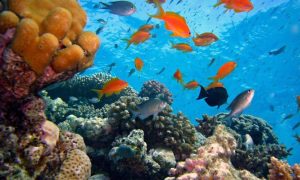
Representative Image (joakant/ Pixabay)
Banana cultivation typically involves clear-cutting large swaths of rainforest and near-constant water usage. Bananas also are typically farmed as monocultures, meaning they are the only farmed crop, which also makes them vulnerable to diseases. As a counter, banana farmers — typically working for large, multi-national corporations — make intensive use of harmful chemicals and pesticides, the runoff of which has been documented to have contaminated precious soil and water resources.
This contamination not only can harm coral reefs and fish but also reportedly has led to higher rates of cancer, birth defects, and miscarriages in humans in the surrounding communities. Many of the largest banana exporters — including Ecuador, Colombia, Costa Rica, and Guatemala — have poor records regarding labor law enforcement, including regarding child labor. A 2002 report from Human Rights Watch identified prevalent use of children — as young as age eight — working 12-hour days rather than going to school. A 2016 report from the U.S. Department of Agriculture also documented the continued use of child workers.
As an alternative, try shopping at your local farmers’ market to buy food grown near you that’s in season!
14. Chocolate
Who It Hurts: Forest dwellers, children, companion animals (if ingested)

Representative Image ( Joerg Sabel/Adobe Stock)
Chocolate production also typically involves deforesting rainforest land, including in the Western African countries of Ghana and the Ivory Coast, which produce about 70 percent of the cacao sold to chocolate processors. In addition to endangering biodiversity, the chocolate industry also is riddled with reports of child labor — with an investigation from Tulane University reporting an estimated 2.12 million children engaged in chocolate production in 2013-2014 alone. The report noted that many of these children had reportedly been kidnapped or trafficked by their parents, who reportedly believed the children would be treated well. But the reality was that even very young children, including those who were 5 years old, were forced to carry heavy loads, wield machetes, and work up to 100 hours each week — including at night.
Chocolate also includes theobromine, a toxin for dogs and cats — so make sure to keep it away from your furry friends!
If you’re looking to make more ethical chocolate choices, make sure your purchased brands are carrying a fair-trade logo. While the label doesn’t guarantee child labor wasn’t used to produce the sweets, it does mean that the companies had to meet baseline sustainability and labor standards. One such brand is the Endangered Species chocolates. The Food Empowerment Project also has a free, downloadable chocolate app which allows searches for individual brands of chocolate to see if child labor likely was involved.


